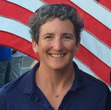Carol Newman Cronin's Blog, page 14
April 13, 2023
Toppa Talks: One Job, One (Big) Dream
I just reread the double-feature I wrote about Mike Toppa in the March issue of Seahorse Magazine, and wow it packs in a lot of information! Written right on the heels of Peter Harken’s (also a double, and not out quite yet), it’s no wonder I took the winter off from writing profiles.
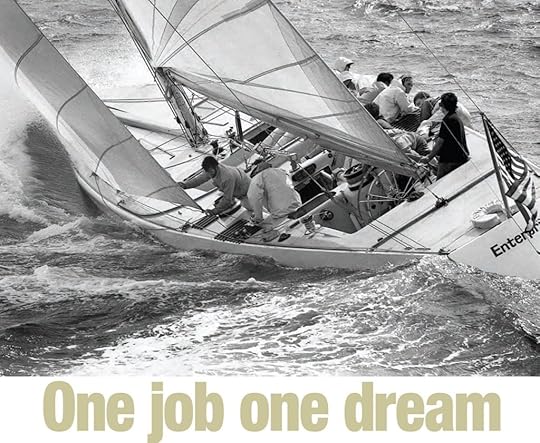 Never heard of him?
Never heard of him?Standing on the dock racing model boats in Newport Harbor alongside this quiet but quite intense guy, I realized he would be a great profile “victim.” Mike grew up in Newport, and he’s got lots of stories about the far-better-known Jerry Kirby… while Toppa, as most locals call him, is one of the most impressive sailors you’ve probably never heard of. He’s not exactly long on self-promotion, and his most impressive victories (two or three America’s Cup wins, depending on whether you include his tween-age dockboy adventure with Intrepid) all came as part of a large team. He started designing race-winning spinnakers for North Sails when testing the shape of a new design meant hoisting it up the loft’s flagpole. Needless to say, things have changed quite a bit since then, but—as he puts it—he’s only ever had one job.
My suggested headline: “Only One Job”Seahorse improved on that by adding a reference to Toppa’s singular childhood dream: to win the America’s Cup. He did just that in 1980, with Dennis Conner, but since he was “only” the spinnaker designer he was still hungry to win as a sailor. For the 1992 Cup, he combined his sail design expertise with an unbeatable passion for racing sailboats to earn a spot as headsail trimmer on America3, back in the days when there was a designated trimmer on either side of the huge IACC cockpit. When they won, he finally got to cross the finish line as a sailor. “And I got to sail every race in that Cup with Jerry Kirby!” he adds. “So go back to being a little kid, learning how to sail and saying that’s what we’re gonna do. And we did it, together.”
A “glass-half-full” guyAs I put it in the intro, “Toppa’s default facial expression is a smile, and he exudes a comfortable calm; not the usual demeanor at the pointy end of our sport.” That of course made for a very fun interview (and story). He even manages to keep smiling when he gets taken out by another model boat!
Seahorse has graciously provided a PDF so you can read more about Toppa, but to read the latest from Rod Davis (and all the other great columnists) you’ll have to subscribe.
Read One Job One Dream
PS I did spot one error that my “victim” was gracious enough not to mention, but since most readers won’t even notice I’m going to let it go. (If you did find it, definitely let me know.)
Okay, now that I’ve had a few months off from writing profiles, who should be my next “victim?” Add your suggestions in the comments below, or send me an email. I read and appreciate every single one.
Visit the Seahorse website
Previous Seahorse ProfilesCircus Minimus: The Rich Life of Bill Mattison
Mark Reynolds: Hard Chines and Unasked Questions
Dawn Riley: Setting the Standard
Clicks of Chance: Onne van der Wal
Just Say Yes: Stan and Sally Honey
Rod Davis: Why You Need His Wisdom in 2021
Rod Johnstone: An Amazing Legacy of Yacht Designs
A Final Conversation with Harry Anderson
Vince Brun Profile in Seahorse
The post Toppa Talks: One Job, One (Big) Dream appeared first on Carol Newman Cronin.
April 6, 2023
Swimming in a Sea of Salty Dialogue
A few days ago, I had just stepped out onto the front porch to breathe in the unique promise of April on Narragansett Bay when a voice in my head announced: “Shut ‘er down, Cap!”
“Of course!” I thought. “In that chapter I just edited, so-and-so says that as a joke.” And I immediately rushed back to my desk to write it down, because I’ve learned that even the most ah-HAH! ideas can definitely be fleeting.
I wrote back in 2010 that “I never know what might sneak in while I’m thinking about something else.” In 2018, I mused in Woolgathering Works that “when I’m not actively thinking about anything at all, I ‘learn’ things about my characters.” So this is not a new experience. But what I now understand is the importance—and fun—of this particular stage, which comes only after I’ve completed the first draft. That’s when my characters reveal their best secrets—usually when I’m not actually writing.
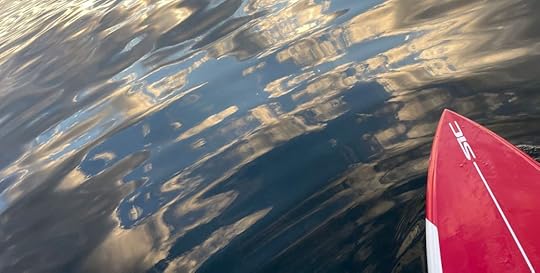
The publishing industry would call this part developmental editing; when authors, often with an editor, smooth out the rough patches in their first drafts. The goal is to solve any “big picture” plot issues, as well as removing inconsistencies in voice or structure. The best editors will also gently point out what “darling” characters or scenes just aren’t necessary.
I prefer to handle this enormously important step on my own, because it’s my reward for slogging through that sh*tty first draft and finding out what happens! Now that I know most of who does (or doesn’t) do what with whom, I start again from the beginning and work through what I’ve written so far; tightening what’s really necessary, and moving everything else into an “old scenes” folder.
And somewhere along the way, my characters become quite playful. It’s like we’re all standing waist-deep in a sun-warmed ocean, playing a strange authorly version of “Marco Polo:” they call out phrases, which I then try to both remember and filter. There’s plenty of trash talk, but there are no bad suggestions; we’re all brainstorming together, supported by a salty sea of words (which can sometimes be mistaken for a sea of salty words).
You’ll notice I’m not giving away any plot details yet, because the frame I built with that rough draft is not yet truly locked into place. It still needs its corner braces; all of those key scraps of dialogue that bring each scene to life.
I’m grateful this part is so much fun, because there’s got to be a more efficient path toward a finished book… like working with a developmental editor! But as a seat-of-the-pants writer (known in the industry as a pantser), I’m also absolutely certain that adding more structure would scare away all the voices now dogpaddling inside my head. This is the only way I know to complete a story worthy of sharing, even if it’s hard to explain.
Got a question about my writing and editing process, or want to share your own? Drop a comment in below, or send me an email. I read every one, with an ocean-full of thanks.
And now it’s time to “Shut ‘er down, Cap!”
Previous writing postsFavorite Writing Blog: Guest Post!
3 Writing Lessons from Olympic Sailing
Trusting Myself—and My Writing Process
The post Swimming in a Sea of Salty Dialogue appeared first on Carol Newman Cronin.
March 30, 2023
Thank Your Awesome Teammate Day, 2023 Style
Three years ago, shortly after the world shut down, I designated March 19 as Thank Your Teammate Day. (I admit, it was partly to distract myself from sheltering at home when I was “supposed” to be racing Snipes in Miami.) The following year I wrote (again) about the thankless job of crewing, and how skippers need to change that—even when we don’t have an opportunity at an awards gathering.
In 2022, I apparently dropped the whole thing—because the world was opening up again, and there were so many other exciting things to write about. But shouldn’t our “new normal” include regular appreciation of our teammates?
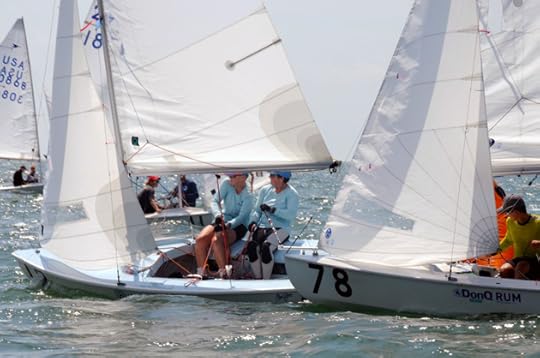 Rounding the leeward mark at the 2015 DonQ Regatta in Miami, FL. Photo: Blake MiddletonCelebrate Thank Your Teammate Day
Rounding the leeward mark at the 2015 DonQ Regatta in Miami, FL. Photo: Blake MiddletonCelebrate Thank Your Teammate DayThis year, I am happily reviving Thank Your Teammate Day (even though March 19 is already past) and weaving it into my “regular” late March tradition: tomorrow, Kim and I will line up with close to 30 other Snipes on the starting line of the 57th DonQ Regatta. Only a pandemic has kept us from racing the DonQ since 2010, because it’s an extra-special chance to catch up with Snipe friends from all over the world for some Serious Sailing, Serious Fun; that unique balance of competition and camaraderie so perfectly captured by our class motto.
Thanks to a lot of hard work by others (and that unique Snipe vibe), the 2023 fleet is a wonderful mix of Snipe veterans and Under-30s, who are just learning to appreciate the Snipe family—and who will continue this tradition long after the veterans retire. This success is drawing some press; Dave Powlinson has been asking questions for an upcoming article in Sailing World. After more than thirty years of struggling to describe what’s so great about the Snipe, I look forward to reading his take: why a design that’s almost 100 years old continues to attract such impressive talent—and so many strong personalities—over a wide age range.
My best DonQ result with Kim (so far) was a second place in 2018, despite a major weather event that derailed her careful travel plans. I’m sure I wouldn’t have done nearly so well (and might have gone home myself) if she had given up and just stayed home, but fortunately giving up (on or off the race course) is not in her DNA! This year we’re hoping to improve on our 2022 results (17th), but regardless of how we end up, I know we will create some fantastic new memories.
So, before I forget:
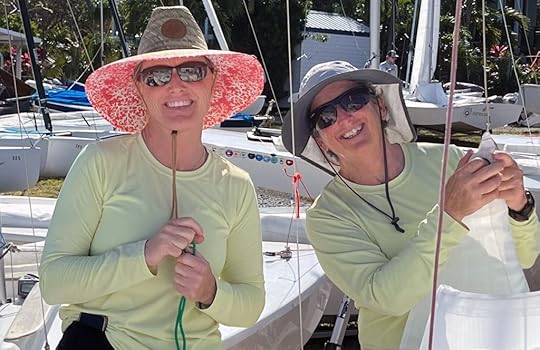 Thanks Kim. I can’t wait to go sailing with you again!
Thanks Kim. I can’t wait to go sailing with you again! Got a teammate you really appreciate but haven’t thanked recently? Add their name to the comments below, or send me an email. I read them all, with (almost) as much gratitude as I have for my supercrew.
PS to Kim: I’ve got a special treat for you this year…
Read more about the Snipe2020 Sailing World article: A World of Snipe
Snipe Sailing, and Writing about it
The post Thank Your Awesome Teammate Day, 2023 Style appeared first on Carol Newman Cronin.
March 23, 2023
Fresh and Not Frightening: the Joy of Writing Teamwork
When I first started freelance writing three decades ago, I thought magazine articles would be my primary focus and I’d get to work with editors on a regular basis. Since then, both magazines and my business have evolved… and for various reasons*, writing one-off pieces is more of an occasional treat than a regular gig. But I always enjoy the chance to work with an editor to develop and refine an idea, so a few months ago I was really excited to receive an email from SAIL Magazine’s Wendy Clarke; would you be interested in writing for us?

Of course my answer was YES!, and Wendy liked my initial idea: a story about the importance of teamwork for all sailors—from family cruisers to professional racers—that might help readers improve the teamwork on their own boats. I reached out to Karen Fallon (who lives on a boat year round, with her husband and two kids); Shirley Robertson and Dee Caffari (two pro sailors who teamed up last summer to spend 13 days racing around Britain and Ireland); and Jack and Zdenka Griswold (retirees who completed a five year circumnavigation). Though their experiences were all quite different, I did dig out some commonalities—and then Wendy helped polish it into a piece that will hopefully educate as well as inspire.
This was my first article for SAIL, and I really enjoyed the challenge of pulling together a story for an audience that includes cruising sailors. Wendy graciously provided a PDF to share with all of you, but I encourage you to subscribe so you can see all the other great content in each month’s edition. Even on screen, the spreads recreate the excitement of a “traditional” sailing magazine; a feast for both eyes and mind.
Got another story idea you think I should pursue at the cruising end of the sailing spectrum? Share it in the comments below, or send me an email. After all, life works best when it’s a team effort. 
Read Go Team!
Visit the SAIL website
*In Time Capsule: A Letter from 1995, I explained that my first professional goal was writing for magazines… but “what I quickly realized was that it was very hard to justify the time and effort put into one-off pieces. The key to making a living as a writer was syndication, which really only worked in a bigger industry—and wasn’t my cup of tea at all.”
The post Fresh and Not Frightening: the Joy of Writing Teamwork appeared first on Carol Newman Cronin.
March 16, 2023
Seahorse Surprise: A Fact-Checking Followup
I love Seahorse Magazine: great writing, incredible photos, and a much longer-term perspective than any other publication—sailing or otherwise. Best of all, I can usually blame the rare typos on their use of UK-English.
(Full disclosure: As a bylined writer, I may be somewhat biased.)
All of that explains why, even though I don’t have aspirations to sail on the big (and VERY big) boats that dominate its pages, I read each issue cover to cover. And I’m frequently rewarded by a surprise lurking somewhere inside.
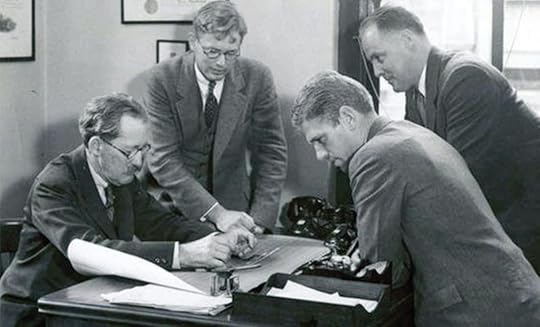 One of the many historical photos dug up by Seahorse Magazine (Olin Stephens is second from left)
One of the many historical photos dug up by Seahorse Magazine (Olin Stephens is second from left)February’s coffee-spitting guffaw was especially personal; a subtly placed correction in the Snapshots section, in response to my request for a small fact check a few months earlier. Here’s what happened; in early December, I passed the November issue of Seahorse to my father, knowing he’d enjoy my tribute to Bill Mattison—and, maybe even more so, appreciate Julian Everitt’s article about Sparkman&Stephens (Olin was Dad’s friend and colleague). The next morning, my sharp-eyed father reported a factual error—in the S&S piece. Olin had not flunked out of college, Dad explained; he had left due to illness.
I promptly sent the editor an email with the correction. There was no reply—but here’s what I spotted two months later, deep in the Snapshots sidebar.

So thank you to Seahorse, for valuing such an ancient fact highly enough to make a correction—and for making me look good with my father. You’re never too old to want to impress your parents!
My own Seahorse articles include Olympic updates and profiles of prominent sailors, and I usually post them here on the blog, But to see even farther back in time via all of the great historical photos they include each month, you’ll have to subscribe.
Thanks for reading, and please share your thoughts in the comments or send me an email. I read every single one, with gratitude! Now if you’ll excuse me, I’ve got to finish reading the latest Rod Davis article…
The post Seahorse Surprise: A Fact-Checking Followup appeared first on Carol Newman Cronin.
March 9, 2023
“Super Good” Life: Remembering Gonzalo E. Diaz
My first conscious memory of the person I so respectfully called “The Old Man” was, appropriately, on the race course; watching his Snipe, sail numbers barely visible, cross the entire fleet by a mile from the LEFT corner at the 1992 Nationals in Alamitos Bay, California—where the right “always” pays. I soon figured out that hearing his voice in the boat park would be both inspiring and educational: the best example ever of cooperative competitiveness.
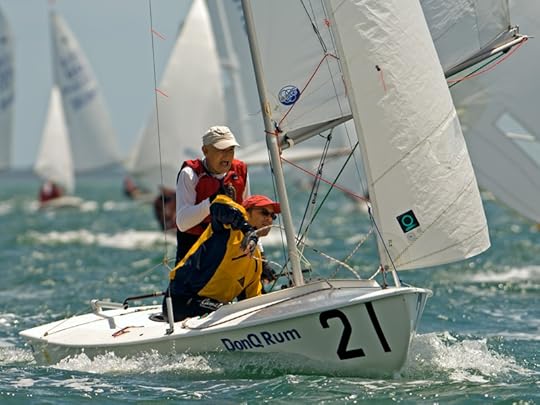 My favorite photo of the Old Man, captured by Fried Elliott at the 2006 Snipe DonQ on Biscayne Bay.
My favorite photo of the Old Man, captured by Fried Elliott at the 2006 Snipe DonQ on Biscayne Bay. The best of many legends is that he sailed his Snipe out of Cuba when the family emigrated to Florida in 1964. The one time I asked him directly about the tale, he explained calmly that it wasn’t true; he and the family took an airplane—after arranging for his beloved Snipe to follow on a ship. First in Clearwater, and later in Miami, Old Man built a successful business and, with Carmen, also raised a family. His son Augie Diaz remembers learning to race in the Clearwater prams before graduating to the Snipe, and he says his father trained his brother Gonzo to be an excellent Snipe crew!
Old Man (it sounds much more respectful in Spanish: Viejo) was also a Snipe champion over many decades. He and his brother Saul won silver at both the 1959 Pan Am Games and Snipe Worlds; in 1971, Old Man and Augie continued the family tradition by winning another Pan Am Games silver medal together. A year later, they won the Snipe Western Hemisphere and Orient (WHO) Championship. It’s no surprise that in 2021, when Augie again won the WHO (this time with Barbie Brotons), the first call he made was to the Old Man.
For many decades, wherever the U.S. Snipe Nationals were sailed, Old Man and Carmen showed up—and for a few years, there were three generations sailing. In 1993, I included a tribute to the family in Why Sail a Snipe?, because I was so impressed that a 13 year old Lucas Diaz, crewing for his uncle Gonzo, “was narrowly beaten by his grandfather for 12th place in the championship fleet… it is clear from their example that significant birthdays need not put a halt to future Snipe fun for many years to come.”
I always enjoyed showing up early for a Snipe regatta at the Coconut Grove Sailing Club, because it gave me a chance to catch up with the Old Man before he was too distracted by helping another junior sailor properly rig their Snipe. How many generations of young sailors did he inspire, outside of his own family? I can’t even begin to count, but there are folks now in their 50s with memories of “renting” a race-ready Snipe from the Old Man for some ridiculously low monthly fee; his way of making sailing affordable, while ensuring they had a little skin in the game. He continued these rentals (and kept competing) until just a few years ago.
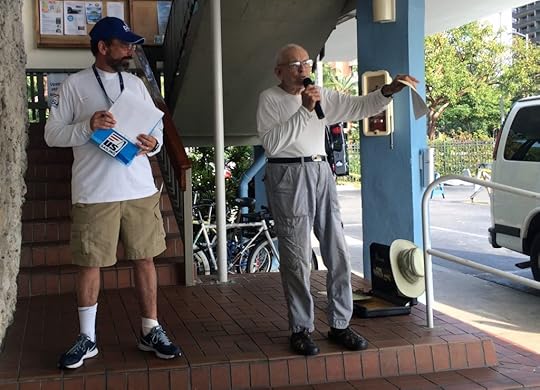 Competitor’s briefings always began with “Attention Snipe Sailors!”
Competitor’s briefings always began with “Attention Snipe Sailors!”There are a few stock “Old Man” phrases that I will hear in my head for many years to come. The most famous, of course, is “Attention Snipe Sailors!” But my favorite was his answer to “how ya doin’, Old Man?” which was always: “Super good, super good!” And then there’s his nickname for my friend and longtime teammate, Kim Couranz: “My Diva!” To which she would answer, “My Hero!”
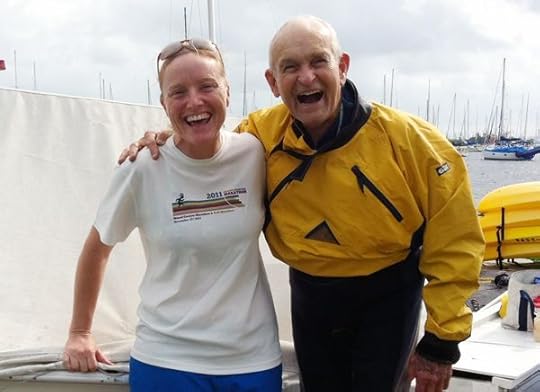
His tales of sportsmanship and leadership were one reason I always made the Comodoro Rasco Regatta a priority. Watching the Old Man narrate home movies from 1950s Cuba (with Comodoro Rasco, the Cuban Snipe Nationals winners, and Castro’s march into Havana given about equal time) never got old.
Old Man is still inspiring good deeds; though it couldn’t possibly begin to match his importance and legacy, I’ve donated a keg to the 2023 U.S. Nationals in his name. I like to think he’ll be smiling down on all of us as we raise a toast to him in late June; the best example I know of cooperative competitiveness. If you want to join me, here’s the link.
Sail on, Old Man. We will miss your wit, your determination, and your love of all things and all people Snipe. I hope your next life is just as “super good.”
The post “Super Good” Life: Remembering Gonzalo E. Diaz appeared first on Carol Newman Cronin.
March 2, 2023
U.S. Olympic Sailing Upheaval: Momentum Lost, Again
Last week, just over 500 days before the 2024 Olympics and not quite four years after their last big upheaval, US Sailing parted ways with yet another Olympic sailing leader. The Friday evening press release was laughingly disappointing; a nothing-burger of corporate marketing-speak that focused on yet another attempt at reorganization. “During a reassessment of its business, to ensure US Sailing Team athletes receive the best support leading up to the Paris 2024 Olympic Games…” A perfect example of the 9 to 5 culture of the organization.
Olympic sailing is a 24/7 pursuit. And Paul Cayard’s own words were much more to the point: “I can no longer work with USSailing.”
A few days later, in an unprecedented show of solidarity, all four senior coaches quit.
There’s never a good time to blow up an Olympic program, and this “quad” is even shorter than usual (since it effectively started after the postponed Tokyo 202One). But the especially frustrating thing is: we’re having the same conversations we had four, eight, and even 20 years ago. As I wrote in September 2019, all the reorganization in the world “won’t solve the basic structural problems this program has been working around for more than decade.”
I was planning to write a brand-new post about what should change, but first I reread what I wrote after the last “restructuring”—and to my dismay, found it quite evergreen. So instead of starting from scratch, here are some choice quotes—with updates on anything I see differently today.
 Different Names, Same Root Problem
Different Names, Same Root ProblemHistory repeatsI haven’t served on the Olympic Sailing Committee since 2016, but throughout this quad I’ve watched (and interviewed) both Greg [Fisher] and Malcolm [Page], impressed by their vision of a cultural shift that would rebuild the U.S. Sailing Team back to medal-winning consistency. As far as I’m concerned, we were finally working in the right direction—though seriously hampered by a lack of solid and consistent funding, as well as those ongoing organizational challenges. Now two great leaders are gone, and there’s no clear indication of how we will dig ourselves out of this Olympic-swimming-pool-sized medal-less hole.
As I think about how we might turn this latest upheaval into an opportunity, I keep returning to the same radical conclusion: we need to rebuild the Olympic program from the ground up. And that sends me right back to the fall of 2004, when a group of us (frustrated by USSailing’s support at the Athens Games) called for a similar reboot. The partial reorganization that followed was, in hindsight, too little, too late; fifteen years later, we’re still trying to catch up with the fully professional model successfully developed by other countries during that same time period.
With a bit more hindsight, I now have a slightly different take: we made some decent progress from 2005-2012, but (as Dean Brenner points out, in his recent letter to Scuttlebutt), an over-reaction to not winning any medals in 2012 led to a radical change of direction and a complete loss of institutional knowledge. Long-term progress is much less glitzy than medals, but it’s what we need to make if we’re ever going to be respected again in Olympic sailing.
Loss of TrustWhile the Olympic Development Program is providing structure for younger athletes (who are posting some great results), the most recent leadership upheaval is teaching the same lesson to yet another generation of Olympic hopefuls: trusting USSailing leads to disappointment. That will make both medal-winning and fundraising harder, for years to come.
Unfortunately it looks like the Olympic Development Program is not as well-funded as it once was… and apparently, the entire rainy-day fund from the 1984 Olympics has been squandered—with no lasting legacy to show for it. Which is even sadder news than the loss of yet another well-known leader, though it does help to explain the loss of one of my favorite coaches….
Get out the TNTSo as my mind swirls around where we are, how we got here, and how to learn from our past mistakes, I keep coming back to a basic realization; deep-seated problems cannot be fixed by slapping bandaids on the existing structure. Malcolm believes that “all the pieces of the puzzle are here” in the U.S., and I agree. Disruption is never something we seek out, but here we are… so let’s get out the TNT and blow up the whole thing right now, while we have the chance.
What would the US Olympic Sailing program look like today if we had indeed taken the big leap into the unknown four years ago, and developed a brand new structure? I can’t imagine we’d be any worse off than we are right now—and we might have already rebuilt some of that lost momentum.
 A Thankless Job
A Thankless JobUSSailing is now looking for two people to do Paul Cayard’s job, along with several coaches—and I can’t think of anyone who could possibly fill those big shoes. Which is why I feel even more strongly today that continuing under the 9 to 5 USSailing umbrella simply cannot lead to success in a 24/7 Olympic pursuit.
Setting up a new program is a very scary and large leap into the unknown, but as they say: “Never let a big disaster go to waste.” Now that we’ve again sacrificed the momentum for this quad (and for LA2028), along with all of our institutional knowledge, it is—once again—the perfect time to build something that will last more than four years; a program that will actually “ensure US Sailing Team athletes receive the best support.”
Agree? Disagree? Share your thoughts in the comments below, or send me an email. I read every single one, with Olympic-level enthusiasm!
Previous Olympic PostsWhat Wins Olympic Medals? Not What Wins Headlines
Tokyo 2020ne: Inspirational Magic
AP over 2020: Lessons from a Postponed Olympics
U.S. Olympic Sailing: All Change
The post U.S. Olympic Sailing Upheaval: Momentum Lost, Again appeared first on Carol Newman Cronin.
February 23, 2023
Time Capsule in Sailboat Racing
“Actually, there is some controversy over who arrived first, Carol or the boat,” her mother jokes. “Put it this way, they were both late.”
That’s a quote from Sailing Away, a Cape Cod Times article that published during the 2004 Olympics. I dug it out for the chalk talk I gave last week at the Upper Keys Sailing Club (UKSC), after two separate people (my husband Paul and the Commodore) suggested exactly the same topic: “We want to hear about your background and where you came from.”
As I replayed my own history, I quickly realized that only one of my three sailing progressions (from local sailor to Olympian, from National Champion Snipe crew to world-champion Snipe skipper, and from keelboat sailor to wingfoiler) could have taken place at any other moment in sailing history. Here, then, is a time capsule of sailboat racing during the past 50 years.
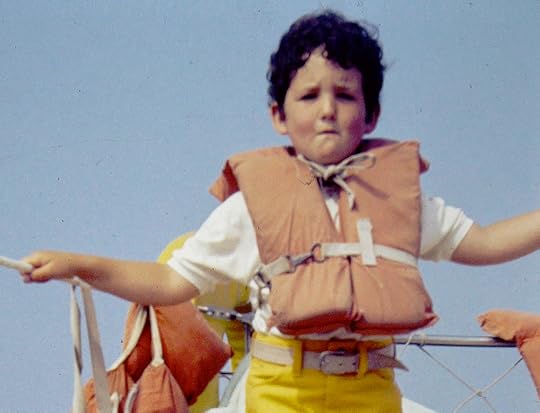 Early sailing
Early sailingI went for my first sail at 10 days old, on a cruising boat that arrived the day I was born. (See Mom’s quote, above.) My two older siblings like sailing, but neither has made it quite such an integral part of their career.
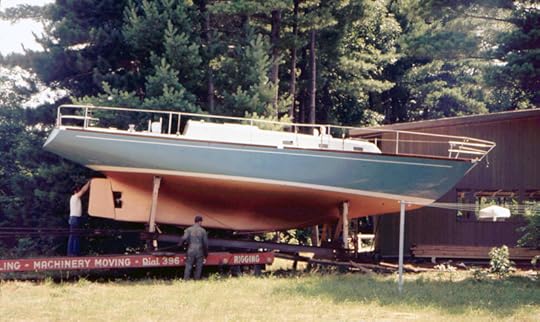
The winter I was six, my parents bought a Morgan 38 hull and deck and had it shipped up to our Massachusetts back yard. Over the next six months, we all pitched in to help get Katrina ready for launching. I suspect we did our very first race that summer, though the boat lacked many of the speed and comfort amenities my father would add over the next 53 winters. She is still an important part of the family, though her racing days ended back in the early 1980s.
Growing up, regattas meant sailing to wherever in New England the start would be, followed by two to five days of racing with a crew of seven (all of us living on the boat), followed by a sail back to Woods Hole.
At age 10, Bob Bigelow introduced me to the joys of racing smaller boats that were, at least in theory, one design. “Bigelow remembers an inquisitive young girl who was hooked on sailing,” that same Cape Cod Times article says, adding a quote from Bobby that I just love:
Undergraduate and “Masters Degree”‘She was possessed with sailboat racing, and very intense,’ he said. ‘She just loved to sail and race.’”
The Connecticut College Sailing Team introduced me to two-person planing dinghies and the benefits of repetition, while my more serious teammates showed me that there were regattas happening all year. Most of the coaches I’ve ever worked with have, at one point or another, told me that “You should’ve steered in college,” but in those days, I was perfectly satisfied to absorb and learn as a crew.
After graduation, I tried to settle back into local summer-only sailing—but I missed the adrenaline rush of more serious competition, as well as the winter escapes. A college friend introduced me to Ed Adams and the Snipe, which turned into a master’s degree in one design racing (and a Sailing World cover, thanks to Onne van der Wal). I also crewed for several other Snipe legends, and along the way I dabbled in the Olympic women’s singlehanded class—only to learn that I really didn’t like racing by myself. Best of all I met my husband Paul, and we married in 1998.
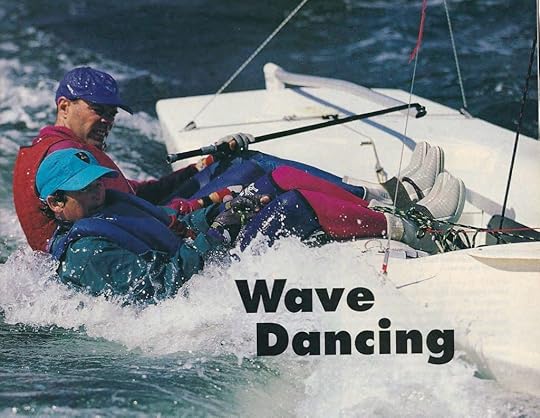 Keelboats and Olympic Dreams
Keelboats and Olympic DreamsIn 1999, I was on the winning team for the Rolex International Women’s Keelboat Regatta and finished third with a different skipper at the very first Women’s Match Racing Worlds. The 2004 Olympics were supposed to include a new medal in women’s match racing (partly to help the sport reach gender parity), and I was eager to be part of an Olympic campaign. But in November of 2000, when the medal was finalized (fleet racing in the Yngling, a three person boat), it was like losing a game of musical chairs; there was one less “seat” on each team. If I wanted to continue, I’d have to start my own program.
Thanks to a lot of encouragement from Paul and the rest of my family, I bought a boat and put together a team. Over an intense two and a half years we developed a little extra speed in light air, and that’s how we won the Olympic Trials in February 2004 on Biscayne Bay. I’ll never forget the catch in my Dad’s voice when I called to tell him we were going to Athens—without even sailing the last race. (“I’ve gotta go tell your mother!”)
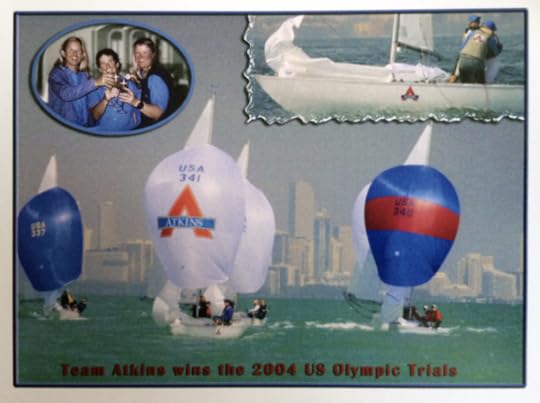 2004 Games
2004 GamesAthens was known for light air, and after finishing third at the 2004 Yngling Worlds we were definitely considered medal favorites. We did win two of the sixteen races. But we also embarrassed ourselves by broaching, right in front of the Acropolis! Tenth place seemed like a complete failure—until we got home, and realized how special it was to be an Olympian. The challenge was, how to put everything I’d learned to use? Most of it really only applied to another Yngling campaign.
So, after a year off, I started working toward Beijing 2008 with new teammates. We finished seventh at the 2006 Worlds and tenth in the Olympic Test Event. But by January 2007, when I looked around the Yngling boat park in Miami, I had a gut-thumping realization: we were the only team still working within the old part-time model. Our (younger) competitors had only one task, to train and race—while we had jobs, mortgages, and families.
Back to Keelboats, and SnipesAnd so I made the difficult decision to retire, and sold my two Ynglings (at their peak value, since the fickle Olympic winds soon blew in match racing and the Elliott 6m for 2012). I moved into a new role, trying to help modernize the US Olympic Sailing Team—because the world had left us behind.
Fortunately, unlike Olympians from most other sports, I could also continue to compete at a high level. The Rolex International Women’s Keelboat Championship provided an excuse to get three friends together on the J/22, and by the time that faded away Kim Couranz and I had teamed up in the Snipe. Over the past thirteen years, we’ve attended several international Snipe championships; we even took home the Women’s Worlds trophy in 2018.
That Foiling ThingWhen the Moth first came on the scene, I was very intrigued—until I saw the price tag, and realized how long it took to rig and unrig. Paul added foiling to his windsurfing, but I continued to sit on the sidelines.
And then wingfoiling was born, and I just had to try it.
In 2021, we bought equipment and started falling and learning and learning and falling. At almost 60 years old, it’s been a huge challenge to master something so completely new—but also one I can adjust to fit my schedule and attitude. I have no interest in wingfoil racing, but it sure is fun to use all my sailing skills and physical abilities to go just a tenth of a knot faster than my husband. It’s definitely putting all of those 10,000 hours I accumulated to good use, though the “trophy” is much less obvious.
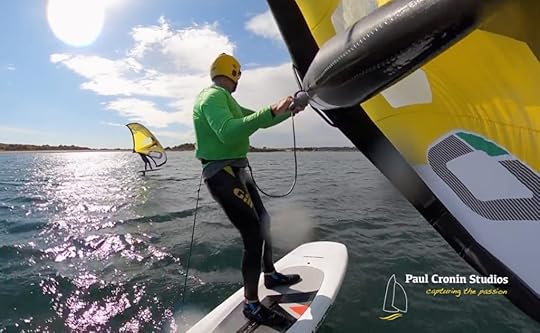 Faster, Smaller, More Intense
Faster, Smaller, More IntenseToday, foiling has taken over the top levels of sailing. Olympic keelboats have been pushed aside by foiling cats and kites, and there’s even talk of a wingfoiling medal. Teams are smaller, too; no more three-person boats at the Olympics, and even America’s Cup sailing teams have drastically shrunk in size. But I have no doubt that if I were in my 20s today, I’d still somehow find a way to join the crew of a top level team. As my Mom put it in that Cape Cod Times article, “perseverance is another of her daughter’s attributes; ‘She’s battled back from behind many times.’” Also, there’s just no substitute for the intensity I apparently possessed, even as a precocious 10 year old.
And yet I’m very glad I grew up when I did, with so many opportunities to learn at a comfortable pace as my skills and interests evolved. This history reads like a time capsule now, because it could not have taken place at any other moment in sailing history. I can’t wait to see what happens next!
 Bonus question
Bonus questionNow that you’ve made it through this personal time capsule, which one of my three sailing progressions (local sailor/Olympian, Snipe crew/Snipe skipper, and keelboat sailor/wingfoiler) could still take place today? Share your thoughts in the comments below, or send me an email. I read every single one, with gratitude.
The post Time Capsule in Sailboat Racing appeared first on Carol Newman Cronin.
February 16, 2023
Have You Thanked a Sailing Volunteer Today?
This week, I want to say a heartfelt THANK YOU to every single person who’s ever stepped up to help with race committee or sat through a meeting with the goal of helping the sport of sailing move forward. You are all an inspiration.
Why is this on my mind today? Because last night I gave a presentation at the Upper Keys Sailing Club, a small grass-roots piece of waterfront that ran a great Snipe Midwinters the previous weekend. My goal was to try to give back, my own little tiny piece of volunteerism. But really I got more out of it than I could possibly give, which makes it feel less like volunteering and more like a priceless gift—to myself.
 Snipe Midwinter History
Snipe Midwinter HistoryThe first Snipe Midwinter Championship took place in 1938 in Clearwater, Florida, but various factors knocked the regatta off the calendar about five years ago. It was fantastic to have this classic revived for 2023, especially over the weekend immediately following the Comodoro Rasco in Miami—and in such a fantastic and different venue! Flat (warm) water, great breeze, and a very quick sail back to the beach after racing. What could be better?
The regatta would never have happened without a ton of work behind the scenes. Snipe Class volunteers coordinated with those who keep the UKSC thriving, finding a rare open weekend on both winter calendars. A race committee already tired from running a huge Opti regatta the previous weekend showed up once again, working hard to set us a square course. And then there were the folks who cleaned up after Saturday night’s Cuban dinner. Dare I suggest that you’ve all helped start a new Snipe Midwinter tradition?
A perfect example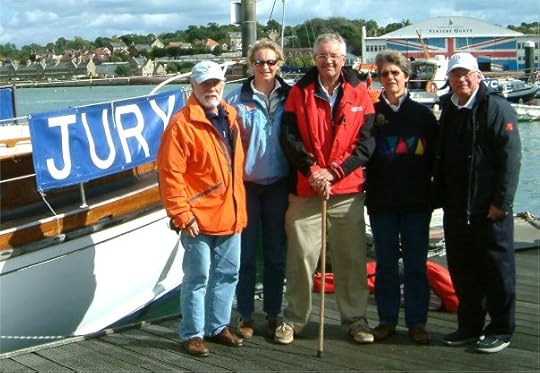
It’s been nine years since we lost Hugh Elliot, but to me Hugh still represents the absolute pinnacle of volunteering. Here’s what I wrote in 2014:
How do we keep this going?Hugh gave back to the sport with his time and his expertise, but he also shared a passionate belief in common sense—as well as the theory that it’s not exactly common after all. I will miss our conversations at sailing events around the world. But more than that I will miss his quiet belief that doing the right thing, to the best of our ability, at all times, is its own reward.
No matter how professional our sport becomes, I hope we can continue to keep volunteering at the core of grass roots sailing. That will of course require that most of our dedicated volunteers continue to feel as Hugh did and I do, that when we offer up our free time we get more out of it than we give. I have no idea how to help make that happen, except by doing my own little tiny part to help others better enjoy their time on the water.… but if any of you have ideas, please share them in the comments below (or send me an email).
And once more… thanks to all of you who make it possible for me to go sailboat racing, most especially to all the volunteers at UKSC!
The post Have You Thanked a Sailing Volunteer Today? appeared first on Carol Newman Cronin.
February 9, 2023
Mechanics vs. Flow: A Thought-Study in Irony
This week’s post was inspired (as so many are) by an offhand comment that dropped into my subconscious at just the right moment. I can’t remember the exact words, but they instantly stimulated thoughts about the “mechanics” of life vs. the “flow” of life.
As usual, I’m taking someone else’s initial idea well beyond its original context… so, as usual, the opinions here are all my own. Take them or leave them as it is useful to you!
FYI: Though I use writing as my example, this applies equally well to sailboat racing. Or, for that matter, to anything at all that we care enough about to practice and repeat.
 What I mean by “mechanics”
What I mean by “mechanics”To complete any task, we all have to master some level of technique. We only get better with practice, and the better our technique the more we can take the mechanics of that task for granted. After writing so many blog posts, I can spend far less time thinking about word choice or when to start a new paragraph and more time just getting down my thoughts.
Only once the mechanics become automatic can we possibly achieve flow.
What I mean by “flow”Athletes say they’re “in the zone” when they reach an effortless state of excellence. Many fiction writers (including yours truly) sometimes get to listen to our characters and just write down what we’re “told.” Maybe you’ve experienced flow while driving a car, when you suddenly come to and realize you haven’t really “seen” the last few miles of highway because you’ve been thinking about something else entirely—and yet you are still safely piloting the vehicle to your destination.
We all strive for flow, but even for the very talented it’s an elusive goal.
Here’s the ironyWhat that recent comment made me realize is this: we have to keep working on our mechanics if we ever hope to achieve what seems like their total opposite, flow. Repetition and practice may seem dull, but they are the only controllable aspects of building skills. If we consciously chase flow, we will scare it away—kind of like that butterfly of an idea that landed on and then flew away from Elizabeth Gilbert (eventually helping to inspire what I would argue is her greatest book ever, Big Magic).
When seeking flow, we need to concentrate on our mechanics—even after they become second nature.
Keep on doingIt’s all too easy to think we’ve already mastered something; that all the work we put into previous novels will make the next story easier to write. But just like the investment folks say, past performance is no guarantee of future success—at least not for any task worthy of our continued efforts. It takes true discipline to go back to work on the mechanics after achieving flow, but that’s the only dependable path to our next goal.
I don’t know if any of this is useful to anyone else (or even whether it makes sense), but as I slog through the mechanics of book number six I’m grateful to my random commenter for this timely reminder: we only produce a great end result by putting time into the pesky details. If we do a really good job, focusing on the mechanics may even lead to flow—even if that seems counter-intuitive.
Got a thought about mechanics vs. flow? Share it in the comments below, or send me an email. Thanks, and who knows… you might just inspire another blog post!
The post Mechanics vs. Flow: A Thought-Study in Irony appeared first on Carol Newman Cronin.

